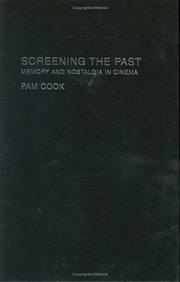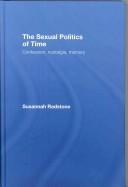| Listing 1 - 10 of 19 | << page >> |
Sort by
|
Book
ISBN: 128262749X 9786612627491 1845458885 0857451618 1845455592 Year: 2009 Publisher: New York : Berghahn Books,
Abstract | Keywords | Export | Availability | Bookmark
 Loading...
Loading...Choose an application
- Reference Manager
- EndNote
- RefWorks (Direct export to RefWorks)
In this fascinating in-depth study of the impact of nostalgia on contemporary American cinema, Christine Sprengler unpicks the history of the concept and explores its significance in theory and practice. She offers a lucid analysis of the development of nostalgia in American society and culture, navigating a path through the key debates and aligning herself with recent attempts to recuperate its critical potential. This journey opens up the myriad permutations of nostalgia across visual and material culture and their interface with cinema, with the 1950s emerging as a privileged moment. Four c
Nostalgia in motion pictures. --- Motion pictures --- Aesthetics. --- History

ISBN: 0203337824 1280225424 9786610225422 9780203337820 6610225427 041518374X 0415183758 9781134670949 9781134670987 9781134670994 9780415183741 9780415183758 1134670982 Year: 2005 Publisher: London New York Routledge
Abstract | Keywords | Export | Availability | Bookmark
 Loading...
Loading...Choose an application
- Reference Manager
- EndNote
- RefWorks (Direct export to RefWorks)
From Mildred Pierce and Brief Encounter to Raging Bull and In the Mood for Love, this lively and accessible collection explores film culture's obsession with the past, offering searching and provocative analyses of a wide range of titles.Screening the Past engages with current debates about the role of cinema in mediating history through memory and nostalgia, suggesting that many films use strategies of memory to produce diverse forms of knowledge which challenge established ideas of history, and the traditional role of historians.
Nostalgia in motion pictures. --- Memory in motion pictures. --- Motion pictures --- Psychological aspects.
Book
ISBN: 1443816477 9781443816472 1443889067 9781443889063 Year: 2016 Publisher: Newcastle upon Tyne, UK
Abstract | Keywords | Export | Availability | Bookmark
 Loading...
Loading...Choose an application
- Reference Manager
- EndNote
- RefWorks (Direct export to RefWorks)
Golden age (Mythology) --- Nostalgia in literature. --- Nostalgia in motion pictures. --- Motion pictures --- Mythology, Classical --- Paradise

ISBN: 9780415066907 9780415066914 9780203937662 Year: 2007 Publisher: Milton Park, Abingdon, Oxon ; New York : Routledge,
Abstract | Keywords | Export | Availability | Bookmark
 Loading...
Loading...Choose an application
- Reference Manager
- EndNote
- RefWorks (Direct export to RefWorks)
Confession in literature. --- Feminist criticism. --- Feminist theory. --- Nostalgia in literature. --- Nostalgia in motion pictures.
Book
ISBN: 9781438483498 9781438483481 Year: 2022 Publisher: Albany (N.Y.) : State university of New York press,
Abstract | Keywords | Export | Availability | Bookmark
 Loading...
Loading...Choose an application
- Reference Manager
- EndNote
- RefWorks (Direct export to RefWorks)
"Explores how nostalgia operates in contemporary US film and television. Explores the rise of cultural nostalgia in contemporary film and television, from reboots of classic films and TV series like Westworld and the Star Wars franchise to series like Stranger Things and The Americans"--
Motion pictures --- Nostalgia in motion pictures. --- Nostalgia on television. --- Television programs
Book
ISBN: 1438483503 9781438483504 9781438483498 9781438483481 Year: 2021 Publisher: Albany
Abstract | Keywords | Export | Availability | Bookmark
 Loading...
Loading...Choose an application
- Reference Manager
- EndNote
- RefWorks (Direct export to RefWorks)
"Explores how nostalgia operates in contemporary US film and television. Explores the rise of cultural nostalgia in contemporary film and television, from reboots of classic films and TV series like Westworld and the Star Wars franchise to series like Stranger Things and The Americans"--
Motion pictures --- Nostalgia in motion pictures. --- Television programs --- Nostalgia on television.
Book
ISBN: 0231162030 9780231162036 Year: 2012 Publisher: London Wallflower
Abstract | Keywords | Export | Availability | Bookmark
 Loading...
Loading...Choose an application
- Reference Manager
- EndNote
- RefWorks (Direct export to RefWorks)
Nostalgia in motion pictures. --- Motion pictures --- History --- Philosophy. --- Historical films --- National characteristics in motion pictures --- History and criticism
Book
ISBN: 0857451294 178238135X 0857451286 1782381341 Year: 2011 Publisher: New York : Berghahn Books,
Abstract | Keywords | Export | Availability | Bookmark
 Loading...
Loading...Choose an application
- Reference Manager
- EndNote
- RefWorks (Direct export to RefWorks)
Screening the East considers German filmmakers' responses to unification. In particular, it traces the representation of the East German community in films made since 1989 and considers whether these narratives challenge or reinforce the notion of a separate East German identity. The book identifies and analyses a large number of films, from internationally successful box-office hits, to lesser-known productions, many of which are discussed here for the first time. Providing an insight into the films' historical and political context, it considers related issues such as stereotypin
Motion pictures --- Nostalgia in motion pictures. --- Culture in motion pictures. --- Stereotypes (Social psychology) in motion pictures. --- History --- Social aspects --- Political aspects --- Germany (East) --- In motion pictures.
Book
ISBN: 9780190932695 9780190932688 Year: 2021 Publisher: New York : Oxford University Press,
Abstract | Keywords | Export | Availability | Bookmark
 Loading...
Loading...Choose an application
- Reference Manager
- EndNote
- RefWorks (Direct export to RefWorks)
The Presence of the Past offers a new perspective on Hollywood's "New Wave" as engaged with the vitality of sensory experience and the affective imagination. As author Daniel Bishop shows, the soundtracks of several key films of the New Hollywood Cinema of the late 1960s and 70s cultivated an array of sensibilities regarding the American past. This importance of the past exceeded the New Hollywood's acknowledged use of genre revisionism as a vehicle for timely ideological commentary. There was also a vital tendency in this era to locate the past as an object of imagined phenomenal presence.Although this concept of the past never solidified into a self-conscious discourse, it was nevertheless woven into film culture, readable between the lines of criticism, cultural reception, New Wave aesthetics, and in the aesthetic and industrial transformations of sound design and film music. Bonnie and Clyde (1967), Butch Cassidy and the Sundance Kid (1969), McCabe and Mrs. Miller (1971), The Last Picture Show (1971), American Graffiti (1973), Chinatown (1974), and Badlands (1973) are not only key texts of an exciting era in American popular cinema. They are also mediations upon the presence of the past, an image central to the polarities of visceral energy and ambiguous ephemerality, of utopian dreams and melancholy resignation that characterized this cinema. These sensibilities of pastness engage in diverse ways with myth, nostalgia, paranoia, and existential alienation. They are, however, also united by a concern both with the experiential actuality of the past and with the distances that inevitably separate us from this actuality. "In the tumultuous era of the late 1960s and early 70s, several currents of American art and culture coalesced around a broad sensibility that elevated and explored the immediacy of lived experience, whether as an aesthetic or political imperative. But in films set in the historical past, this sensibility acquired complex additional resonances by speaking to the ephemerality of the present moment through a framework of history, myth, nostalgia, and other forms associated with temporal alienation or distance. The Presence of the Past explores the implications of this complex moment in Hollywood cinema through several prominent examples released in the years 1967 to 1974. Key genres are explored in detailed case studies: the outlaw film (Bonnie and Clyde and Badlands), the revisionist Western (Butch Cassidy and the Sundance Kid, McCabe and Mrs. Miller), the neo-noir (Chinatown) and the nostalgia film (The Last Picture Show and American Graffiti). In these films, however, "the past" is more than a matter of genre or setting. Rather, it is a richly diverse, often paradoxical concern in its own right, bridging conceptual territories within soundtrack studies, including the sixties pop score, myth criticism, the representation of media technology, and the role of classical music in compilation scoring. Against a broader background of an industry and film culture that were witnessing a stylistic and aesthetic diversification in the use of music and sound design, The Presence of the Past argues for the film-philosophical importance of the soundtrack for cultivating an imagined experiential understanding of the past"--
Motion picture music --- Film soundtracks --- Nostalgia in motion pictures. --- History in motion pictures. --- Cinéma et histoire. --- Nostalgie --- Musique de film. --- History and criticism. --- Au cinéma
Multi
ISBN: 9781855662858 185566285X 9781782043522 Year: 2014 Volume: 343 Publisher: Rochester: Tamesis,
Abstract | Keywords | Export | Availability | Bookmark
 Loading...
Loading...Choose an application
- Reference Manager
- EndNote
- RefWorks (Direct export to RefWorks)
Age group sociology --- Film --- anno 2000-2009 --- anno 1980-1989 --- anno 1990-1999 --- Argentina --- Motion pictures --- Children in motion pictures --- Nostalgia in motion pictures --- Allegory --- In motion pictures --- Children in motion pictures. --- Nostalgia in motion pictures. --- Allegory. --- Film. --- Kind. --- Kollektives Gedächtnis. --- Motion pictures. --- Argentinien. --- Argentina. --- In motion pictures. --- Motion pictures - Argentina --- Argentina - In motion pictures
| Listing 1 - 10 of 19 | << page >> |
Sort by
|

 Search
Search Feedback
Feedback About UniCat
About UniCat  Help
Help News
News